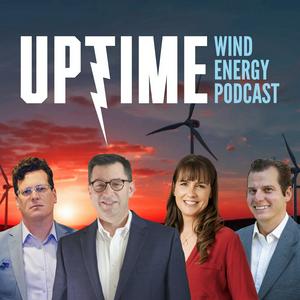Sensing360’s Fiber Optics Catch Gearbox Failures Early
Eric van Genuchten, COO and Co-founder of Sensing360, explains how fiber optic technology is changing gearbox monitoring by catching failures that standard vibration sensors miss. The company's system uses light-based sensors mounted directly onto planetary gearboxes to measure tiny steel deformations and load changes, providing early warning for the 10% of catastrophic failures current monitoring can't detect.
Sign up now for Uptime Tech News, our weekly email update on all things wind technology. This episode is sponsored by Weather Guard Lightning Tech. Learn more about Weather Guard's StrikeTape Wind Turbine LPS retrofit. Follow the show on Facebook, YouTube, Twitter, Linkedin and visit Weather Guard on the web. And subscribe to Rosemary Barnes' YouTube channel here. Have a question we can answer on the show? Email us!
Welcome to Uptime Spotlight, shining light on wind. Energy's brightest innovators. This is the Progress Powering. Tomorrow
I am here with Eric van Genuchten. Uh, so Eric is the COO and Co-founder of Sensing 360. Um, and they are bringing optics, um, to monitoring for gearbox, other rotational equipment. Uh, we're gonna talk a little bit about what that means for the wind industry today, implementation retrofits, uh, from the factory, all kinds of good stuff.
So, Eric, can you give us a little bit of a, of your background? What's, what makes you an expert in the space?
Eric van Genuchten: Uh, that's a good question. So basically my background is. Uh, I studied physics when I was much younger than I'm now, so, uh, I'm not gonna disclose when, but, uh, I've been working since roughly 20 years and I have a background in SKF in the [00:01:00] bearing, uh, uh, manufacturing space.
And basically I've been working within SKF as condition monitoring, uh, solution developer. So I've been in condition monitoring for almost 15 years now. And from SKF, where we developed, uh, condition monitoring systems for all kind of applications, but also wind of course, we went towards, um, load sensing of barrens to be very specific to help our large customers.
And for that we used, uh, fiber sensing. And, uh, eight years ago, seven and a half years ago, uh, I started with two colleagues. I started sensing 360. Which is the 360 is of course the rotation, but we are using five optical sand or optics, uh, for rotating equipment, mainly bearings, large bearings, gear boxes.
And uh, we have been focusing a lot on wind, uh, the last five years, uh, mainly on the planetary gearbox because that's a challenging part from the rotating, uh, [00:02:00] system to monitor. So that's where we, uh, think we can add some value.
Joel Saxum: So I know like, uh, I, I wanna share this with the users too. Our listeners here too, because I came across your technology man, three, four or five years ago or something, uh, over in Europe.
I, I think it was, we were in Copenhagen, wind, Europe and Copenhagen. Um, and I remember seeing you guys in like the startup space and I walked over and you had like, basically what looked to be, um, a stainless steel bearing race on the, on the table. With your sensor package on it and a live readout. And I looked at it and I went to pick it up and I was like, this is interesting.
And when I picked it up, just my hand on it, I looked at the screen and I could see all the deflections happening on the screen from just me grabbing this. And I mean, it was, I mean, you remember what the product thing there was? It was probably four millimeters thick of stainless steel. Like that's not, I'm not squishing that thing with my hand, but you could see it.
Eric van Genuchten: Yeah, no, a lot of people checked if we had a camera around it to see if they were mimicking the move. But basically, [00:03:00] if you ring about it, it's, it's this, this product still, we still have it, it's still operational. And this is the, the, the type of bearing a small, relatively small one for,



